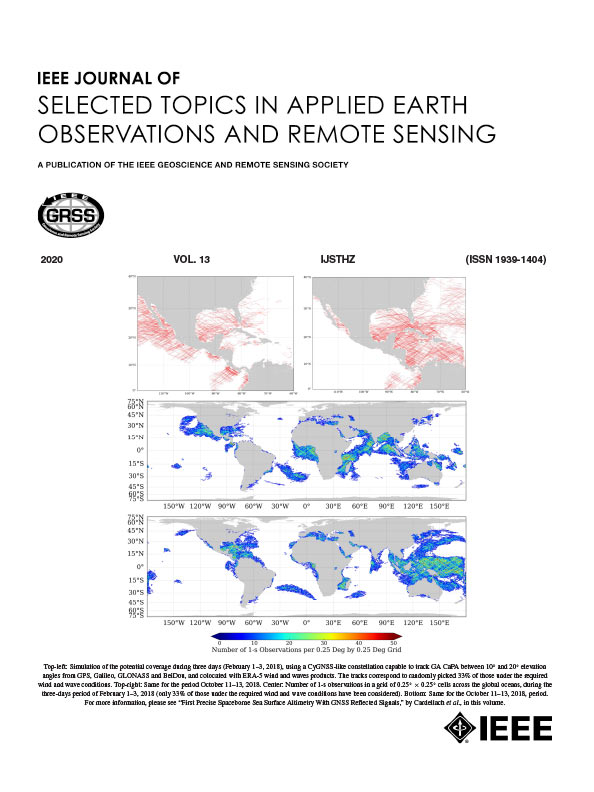基于虚拟全景障碍物图像的三维城市空间导航卫星可视性分析
IF 4.7
2区 地球科学
Q1 ENGINEERING, ELECTRICAL & ELECTRONIC
IEEE Journal of Selected Topics in Applied Earth Observations and Remote Sensing
Pub Date : 2025-03-11
DOI:10.1109/JSTARS.2025.3550341
引用次数: 0
摘要
卫星能见度是评价和预测卫星全球导航系统定位精度和可信度的重要参数。由于卫星信号很容易被建筑物、立交桥和树木阻挡、反射和散射,可见卫星数量在时间和空间上发生了巨大变化。三维(3D)城市模型、点云和全景图像用于计算卫星的能见度。然而,精细化的城市模型需要大量的手工工作,成本昂贵,而具有大数据量特征的点云存在计算效率低的问题。此外,公共全景图像仅覆盖道路区域,无法计算卫星在三维城市空间中的能见度。现有方法无法实现精确、轻量、快速的可见卫星数计算。为此,提出了基于数字曲面模型(DSM)构建虚拟全景障碍物图像的卫星能见度计算方法。考虑GNSS卫星仰角掩模角度,采用自适应方法选择采样点所需的DSM范围,减少数据量。然后,根据确定的距离DSM构建虚拟全景障碍物图像,节省了实时计算卫星能见度的时间;因此,大大提高了计算效率。为了验证该方法的有效性和可靠性,我们收集了实验场点云,构建了高精度的DSM用于计算任意位置的卫星能见度。实验结果表明,该方法提供了一种简单、高精度的卫星时空可视性制图方法。本文章由计算机程序翻译,如有差异,请以英文原文为准。
Visibility Analysis of 3D Urban Space Navigation Satellites Based on Virtual Panoramic Obstruction Images
The visibility of satellites is an important parameter for evaluating and predicting the accuracy and credibility of global navigation satellite system positioning. Since the satellite signal is easily blocked, reflected, and scattered by buildings, overpasses, and trees, the visible satellite number dramatically changes in time and space. The three-dimensional (3D) urban model, point clouds, and panoramic images are used to calculate the visibility of satellites. However, the refined urban model requires abundant manual work and is expensive, while point clouds with the characteristic of large data volume have the problem of computing efficiency low. Also, the public panoramic images only cover road areas, which can not calculate the visibility of satellites in 3D urban space. The existing methods are impossible to achieve refined, lightweight, and fast computation of the visible satellite number. Therefore, we propose the satellite visibility calculation method based on constructing virtual panoramic obstruction images through digital surface model (DSM). The required DSM range of sampling points is selected using an adaptive method considering the GNSS satellite elevation mask angle to reduce data volume. Then, the virtual panoramic obstruction imagery is constructed based on the determined range DSM, which saves time for the real-time calculation of satellite visibility. Hence, the calculation efficiency is greatly improved. To verify the effectiveness and reliability of the proposed method, we collected the experiment field point clouds and constructed high-precision DSM for calculating satellite visibility of arbitrary locations. The experiments demonstrated that the proposed method provides an easy-to-use and high-precision solution to map the spatio-temporal visibility of satellites.
求助全文
通过发布文献求助,成功后即可免费获取论文全文。
去求助
来源期刊
CiteScore
9.30
自引率
10.90%
发文量
563
审稿时长
4.7 months
期刊介绍:
The IEEE Journal of Selected Topics in Applied Earth Observations and Remote Sensing addresses the growing field of applications in Earth observations and remote sensing, and also provides a venue for the rapidly expanding special issues that are being sponsored by the IEEE Geosciences and Remote Sensing Society. The journal draws upon the experience of the highly successful “IEEE Transactions on Geoscience and Remote Sensing” and provide a complementary medium for the wide range of topics in applied earth observations. The ‘Applications’ areas encompasses the societal benefit areas of the Global Earth Observations Systems of Systems (GEOSS) program. Through deliberations over two years, ministers from 50 countries agreed to identify nine areas where Earth observation could positively impact the quality of life and health of their respective countries. Some of these are areas not traditionally addressed in the IEEE context. These include biodiversity, health and climate. Yet it is the skill sets of IEEE members, in areas such as observations, communications, computers, signal processing, standards and ocean engineering, that form the technical underpinnings of GEOSS. Thus, the Journal attracts a broad range of interests that serves both present members in new ways and expands the IEEE visibility into new areas.

 求助内容:
求助内容: 应助结果提醒方式:
应助结果提醒方式:


